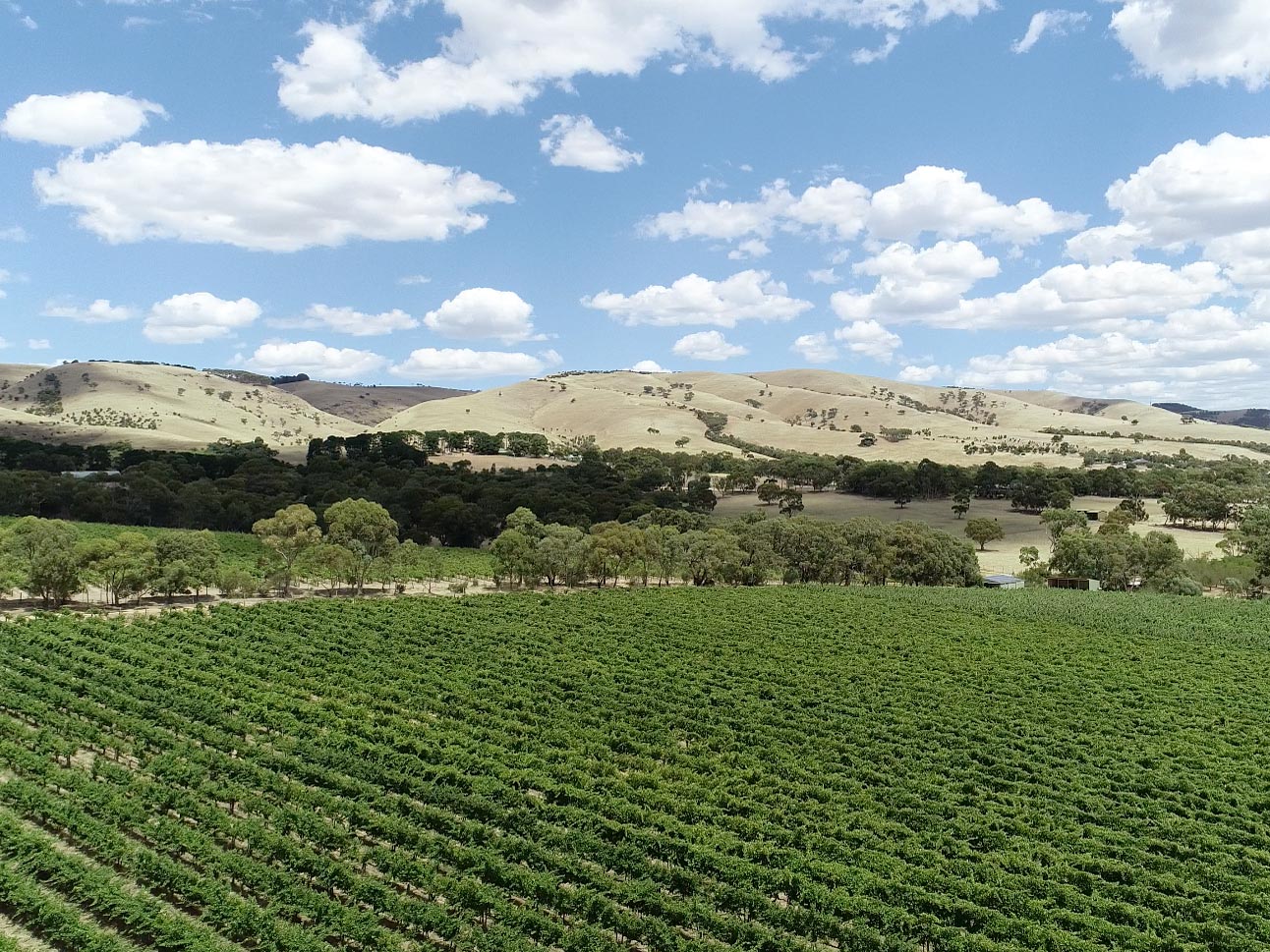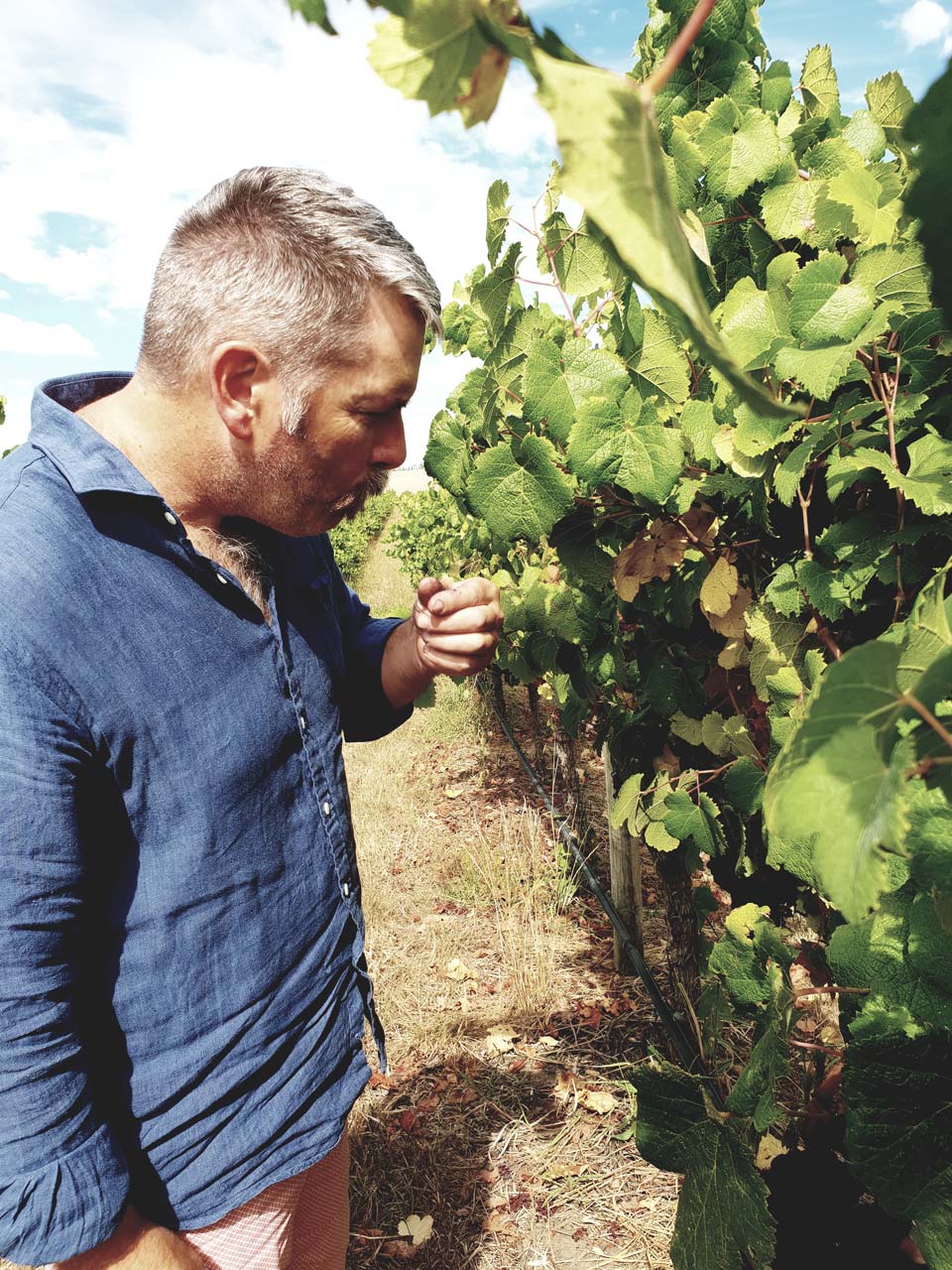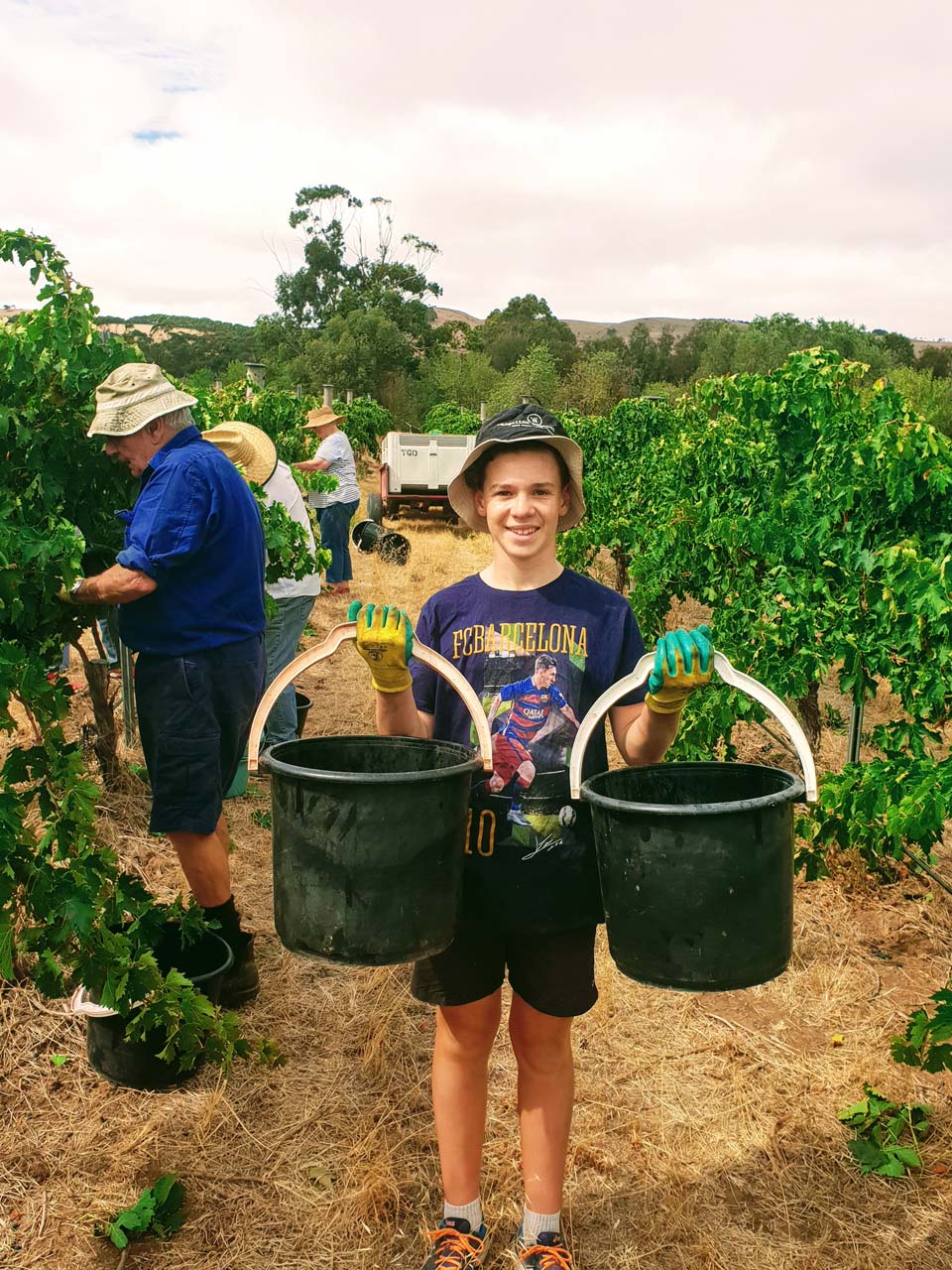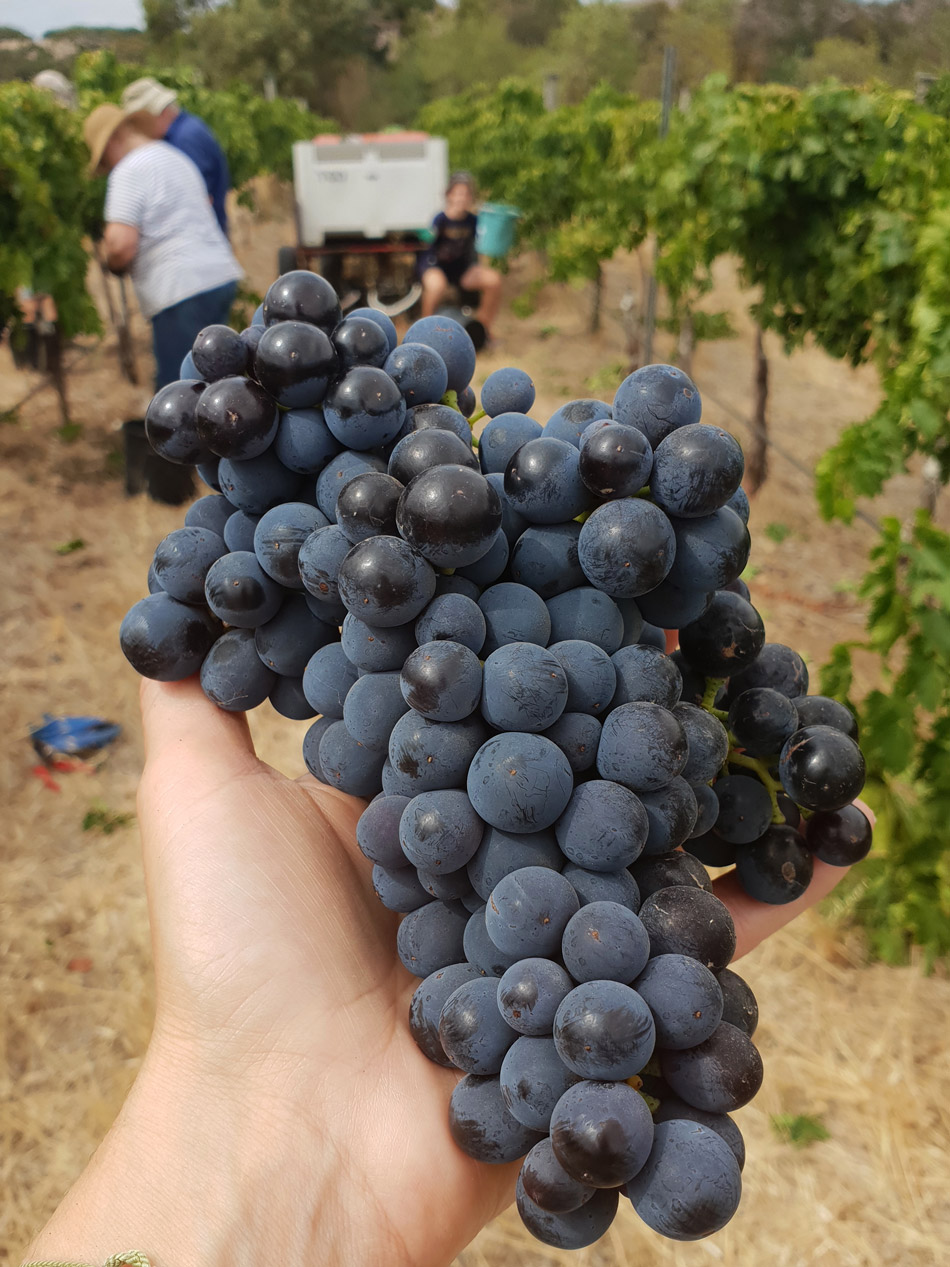Matthew Brown’s Paeroa Vineyard supplies fruit for his range of Dr Plonk and Fu Manchu wines as well as other makers with varieties both traditional and emerging. Tannat and montepulciano have joined stalwart red varieties, and have proven to thrive in the Mediterranean climate of McLaren Vale. His approach is built around organic practices and a regenerative mindset, with input from Richard Leask as a consultant viticulturist. The sustainable practices extend from increasing soil health and organic matter to reducing fossil fuel usage through solar power and reduced tractor passes, while weeds are removed and grasses kept down through both sheep grazing and manual slashing and cultivation. Brown has also taken the supply of grapes to small makers a step further by making winery space available to pursue their own interpretation of Paeroa fruit, which he grows to their individual specifications.
“Paeroa sits where the Willunga Foothills meet the valley floor,” says Brown. “We have unique elevation with direct views to the ocean and welcome cooling sea breezes. It’s a site proving to be best suited to the alternate varieties that have been introduced to the vineyard in the last seven years, they’re growing beautifully and producing fruit that practically makes the wine itself.”
Brown acquired the site in 2009, but it was first planted in 1995/96 with sauvignon blanc, shiraz, cabernet sauvignon and merlot. In 2018, own-rooted montepulciano and carignan joined those more traditional varieties (what was originally thought to be carignan in Australia was recently proven to be the Portuguese variety bonvedro, so growing and making carignan is a more recent thing here), while mourvèdre, tannat and montepulciano were grafted in 2014/15. The vineyard currently has 11.6 hectares of vines.
“I made the call to get rid of McLaren Vale sauvignon blanc, which is not a suitable variety for the region,” says Brown. “That was to make way for grafting mourvèdre, montepulciano and tannat, and then had the pleasure of watching them thrive over the next few years. Merlot was next on the chopping block, as it also didn’t prove to be a winner on my site; it was thin and lacking character. Montepulciano and carignan took its place and are producing two of my most popular wines to date.”
While not certified, the vineyard is farmed according to organic principles. “I am passionate about environmental health,” says Brown, “and continually strive to use innovation and infrastructure improvements to decrease our environmental footprint – solar panels powering winery and bore, reduced fossil fuel usage, no synthetic chemical use, grazing sheep for winter pasture management, under-vine cultivation, reduced trellis post waste through use of OCLOC repair system, moisture monitoring, soil and petiole analysis and use of micronutrients.”
Brown credits lauded viticultural consultant Richard Leask with being an “invaluable resource” of knowledge, which has driven soil health and biodiversity. “Soil health has improved dramatically since the implementation of sustainable practices,” Brown says. “The first major change was to stop the use of synthetic chemical herbicides and pesticides. We then needed to encourage growth of a healthy balance of soil microbes, which we did with the help of organic, local compost, manure and mulch. This biological activity promotes water and nutrients penetration into the soil providing easy access for vine uptake.”
That approach goes beyond the vineyard, too. “I’m a keen advocate for revegetation wherever I can, especially the native corridors along the boundaries and creek lines of the property. I only plant natives that are already growing on and around the site, as they’ve proven themselves drought hardy and ideal for the native fauna. The bigger picture for me is the legacy I leave, that this piece of land I’m responsible for is healthier, more productive and closer to its natural state than when I found it.”
The farming methods have also improved the economic viability of the enterprise, with an increase in quality of fruit driving high demand and premium contract prices, while Brown believes the quality increase in his wines is palpable. He recently held a 12-year vertical of his flagship wine, ‘The Good Doctor’s Tonic’, and believes the proof was in the glass. “A sophistication, refinement and consistency emerged with improved fruit quality,” he notes.
“In the early vintages, all the fruit was sourced from different vineyards, gradually increasing the percentage of my own grown fruit over the years to almost 100 per cent now. Invited to this tasting were notable growers, producers and critics of wine. There was a consensus that there was a significant improvement of wine quality over the vintages that correlated closely with the implementation of sustainable vineyard practices.”
Brown works closely with the makers who buy his fruit, nuancing the approach to specific parcels to achieve certain goals. “We have strong relationships with purchasers of Paeroa fruit, and we respond to their individual requirements, delivering best quality fruit. The resultant wine produced is high calibre, commanding strong prices and retail success. A recent winery expansion also attracts small producers/purchasers to use our winery for wine production. …New ideas and wine styles in the winery push innovation in the vineyard.”
With multiple soil types within the vineyard, from sandy soils to heavy clays, Brown says that separate blocks are managed quite differently and produce significantly different expressions of fruit. “Mourvèdre grown at the bottom of the slope produces ideal fruit for rosé and lighter, lower alcohol wines, whereas the mourvèdre grown at the highest point on the vineyard produces deeper, darker, earthier fruit suitable for bigger dry reds,” he notes as an example.
“For me, it’s been about gaining knowledge on a piece of dirt over time. Making wine with what you actually grow completes the cycle, closes the loop so to speak, so you get to really taste and see what is going on in the vineyard. That then has become the barometer for vineyard practices for me. Over the years I’ve become more comfortable with my site to know what and when it’s going to produce – It’s helped determine timing of pick, cropping, soil balance, and the rest. I’ve been able to maximise flavour, colour and structure – then it’s ready for the winemakers to make it their own.”
That process has involved a lot of experimentation over the years, and lots of false starts, but that’s not something that deters him. “I’m a bit of a gung-ho cowboy when it comes to projects that I’m passionate about. I have an impressive ability to get into trouble but often lack the skill to get out of it. I was raised on 2,000 acres by a fourth gen farmer. Pearls of wisdom from my father included, ‘yeah, nah, she’ll be right’ and ‘g’won, give it a crack’…Advice I have lived by to this day. Turns out she won’t always be right, but giving it a crack has served me well.”
Brown notes that the unique ancient geological formation of the vineyard produces a distinctive structural component in the fruit and the wine, while also having deep varietal expression. “Paeroa Vineyard is terroir personified, from soil to glass,” he says. “This plot of land is a legacy for my children and the planet. It also has the added benefit that it feeds my soul being out in nature. After a gruelling day of work, my go-to is to get into the vineyard and reconnect with my land to wind down. Joy and happiness flow when great fruit and wine is produced.”






